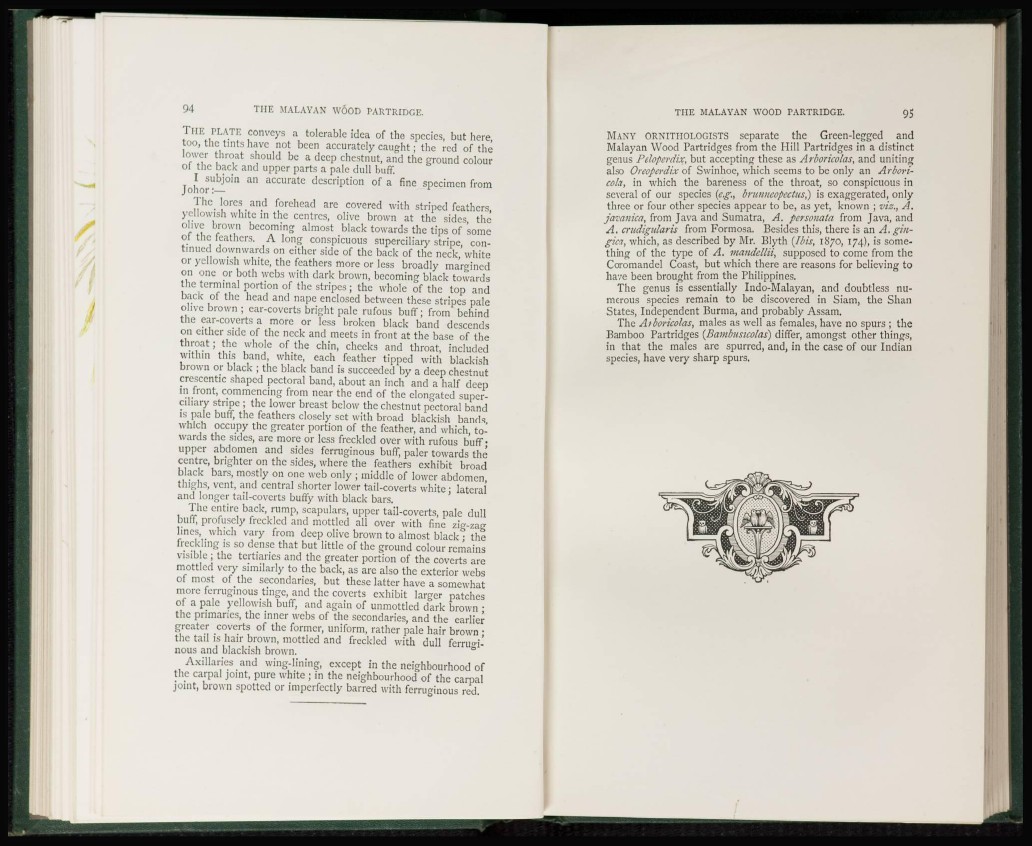
94 THE MALAYAN WOOD PARTRIDGE.
T H E PLATE conveys a tolerable idea of the species, but here,
too, the tints have not been accurately caught; the red of the
lower throat should be a deep chestnut, and the ground colour
of the back and upper parts a pale dull buff.
I subjoin an accurate description of a fine specimen from
Johor:—
The lores and forehead are covered with striped feathers,
yellowish white in the centres, olive brown at the sides, the
olive brown becoming almost black towards the tips of some
of the feathers. A long conspicuous superciliary stripe, continued
downwards on either side of the back of the neck, white
or yellowish white, the feathers more or less broadly margined
on one or both webs with dark brown, becoming black towards
the terminal portion of the stripes; the whole of the top and
back of the head and nape enclosed between these stripes pale
olive brown ; car-coverts bright pale rufous buff; from behind
the car-coverts a more or less broken black band descends
on either side of the neck and meets in front at the base of the
throat; the whole of the chin, cheeks and throat, included
within this band, white, each feather tipped with blackish
brown or black ; the black band is succeeded by a deep chestnut
crescentic shaped pectoral band, about an inch and a half deep
in front, commencing from near the end of the elongated superciliary
stripe ; the lower breast below the chestnut pectoral band
is pale buff, the feathers closely set with broad blackish bands,
which occupy the greater portion of the feather, and which, towards
the sides, are more or less freckled over with rufous buff;
upper abdomen and sides ferruginous buff, paler towards the
centre, brighter on the sides, where the feathers exhibit broad
black bars, mostly on one web only ; middle of lower abdomen,
thighs, vent, and central shorter lower tail-covcrts white; lateral
and longer tail-coverts buffy with black bars.
The entire back, rump, scapulars, upper tail-coverts, pale dull
buff, profusely freckled and mottled all over with fine zig-zag
lines, which vary from deep olive brown to almost black ; the
freckling is so dense that but little of the ground colour remains
visible ; the tcrtiaries and the greater portion of the coverts are
mottled very similarly to the back, as are also the exterior webs
of most of the secondaries, but these latter have a somewhat
more ferruginous tinge, and the coverts exhibit larger patches
of a pale yellowish buff, and again of unmottled dark brown ;
the primaries, the inner webs of the secondaries, and the earlier
greater coverts of the former, uniform, rather pale hair brown ;
the tail is hair brown, mottled and freckled with dull ferruginous
and blackish brown.
Axillaries and wing-lining, except in the neighbourhood of
the carpal joint, pure white ; in the neighbourhood of the carpal
joint, brown spotted or imperfectly barred with ferruginous red.
THE MALAYAN WOOD PARTRIDGE. 95
MANY ORNITHOLOGISTS separate the Green-legged and
Malayan Wood Partridges from the Hill Partridges in a distinct
genus Peloperdix, but accepting these as Arboricolcts, and uniting
also Oreoperdix of Swinhoe, which seems to be only an Arboricola,
in which the bareness of the throat, so conspicuous in
several of our species (e.g., brumieopectus,) is exaggerated, only
three or four other species appear to be, as yet, known ; viz., A.
javanica, from Java and Sumatra, A. personata from Java, and
A. crudigularis from Formosa. Besides this, there is an A. gingica,
which, as described by Mr. Blyth (Ibis, 1870, 174), is something
of the type of A. mandellii, supposed to come from the
Coromandel Coast, but which there are reasons for believing to
have been brought from the Philippines.
The genus is essentially Indo-Malayan, and doubtless numerous
species remain to be discovered in Siam, the Shan
States, Independent Burma, and probably Assam.
The Aiboi'ieolas, males as well as females, have no spurs ; the
Bamboo Partridges (Bambustcolas) differ, amongst other things,
in that the males are spurred, and, in the case of our Indian
species, have very sharp spurs.